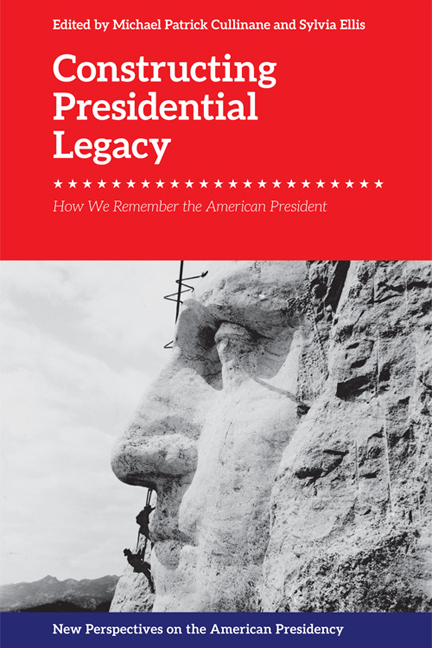Book contents
- Frontmatter
- Contents
- Acknowledgments
- Notes on Contributors
- An introduction to Presidential Legacy
- 1 Presidential Temples: America’s Presidential Libraries and Centers from the 1930s to Today
- 2 Presidential Legacy: A Literary Problem
- 3 Pennsylvania Avenue meets Madison Avenue: The White House and Commercial Advertising
- 4 Eisenhower’s Farewell Address in History and Memory
- 5 Pageantry, Performance, and Statecraft: Diplomacy and the Presidential Image
- 6 “You’ve got to decide how you want history to remember you”: The legacy of Lyndon B. Johnson in film and Television
- 7 The Farewell Tour: Presidential Travel and Legacy Building
- 8 Reflecting or Reshaping?: Landmark Anniversaries and Presidential Legacy
- 9 From a “New Paradigm” to “Memorial Sprawl”: The Dwight D. Eisenhower Presidential Memorial
- 10 Top Trumps: Presidential Legacies, New Technologies, and a New Generation
- Epilogue: Confessions of a Presidential Biographer
- Index
9 - From a “New Paradigm” to “Memorial Sprawl”: The Dwight D. Eisenhower Presidential Memorial
Published online by Cambridge University Press: 01 May 2021
- Frontmatter
- Contents
- Acknowledgments
- Notes on Contributors
- An introduction to Presidential Legacy
- 1 Presidential Temples: America’s Presidential Libraries and Centers from the 1930s to Today
- 2 Presidential Legacy: A Literary Problem
- 3 Pennsylvania Avenue meets Madison Avenue: The White House and Commercial Advertising
- 4 Eisenhower’s Farewell Address in History and Memory
- 5 Pageantry, Performance, and Statecraft: Diplomacy and the Presidential Image
- 6 “You’ve got to decide how you want history to remember you”: The legacy of Lyndon B. Johnson in film and Television
- 7 The Farewell Tour: Presidential Travel and Legacy Building
- 8 Reflecting or Reshaping?: Landmark Anniversaries and Presidential Legacy
- 9 From a “New Paradigm” to “Memorial Sprawl”: The Dwight D. Eisenhower Presidential Memorial
- 10 Top Trumps: Presidential Legacies, New Technologies, and a New Generation
- Epilogue: Confessions of a Presidential Biographer
- Index
Summary
Whenever a society creates a memorial, it communicates across time: it speaks to the future about the past. It offers lessons and admonitions about examples to emulate and to avoid. In United States presidential monuments, America speaks not just about a particular historical personage but also about itself. Although the US Constitution makes the executive a co-equal branch of government, the president is the pre-eminent representative of the nation. Accordingly, when Americans debate the design of presidential memorials, they usually demand monuments possessing qualities commensurate with the esteem that they believe the nation deserves in the eyes of its citizens and of the world. Of all genres of public art, presidential memorials charge their creators with the responsibility to evoke dignity and promote respect.
A judgment about the design of a presidential memorial always involves a dual evaluation. It requires an assessment of the record and reputation of the remembered president; it also demands an evaluation of the proposed form of the monument: how adequate is it to the general demands of presidential commemoration and to the particular remembered figure? These problems have haunted the debates about the design for the Dwight D. Eisenhower Memorial in the nation's capital, for which ground breaking took place in November 2017 after years of wrangling about the qualities of the design.
The designer of a memorial to Eisenhower faced particular challenges. Unlike Franklin Delano Roosevelt and Ronald Reagan, whose legacies define the poles of national policy debates decades after they left office, Dwight D. Eisenhower does not stand for a philosophy of government that remains salient to contemporary political parties, especially not to the contemporary Republican Party. Advocates of an Eisenhower memorial said that he had saved the world for freedom and presided over eight years of peace and prosperity; he combined personal qualities of humility, determination, and toughness; he chose the middle way between extremes. In our time of partisan conflict and tribal polarization, however, Eisenhower's vaunted virtues seemed to belong to an imperfectly remembered realm of bipartisanship far from the realities of politics today. No one, anyway, came up with a convincing idea of how to represent his qualities and achievements in a memorial.
- Type
- Chapter
- Information
- Constructing Presidential LegacyHow we Remember the American President, pp. 227 - 257Publisher: Edinburgh University PressPrint publication year: 2018



